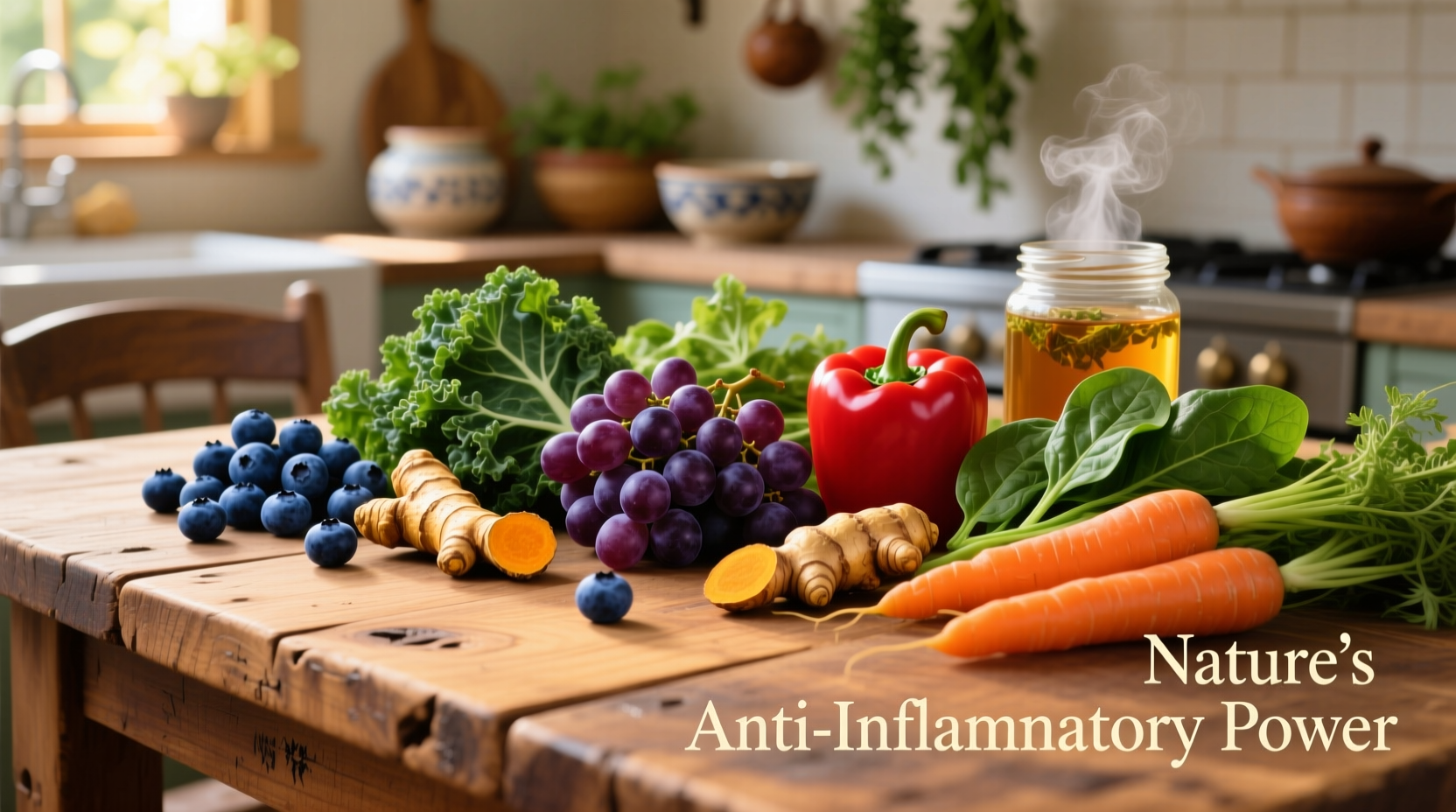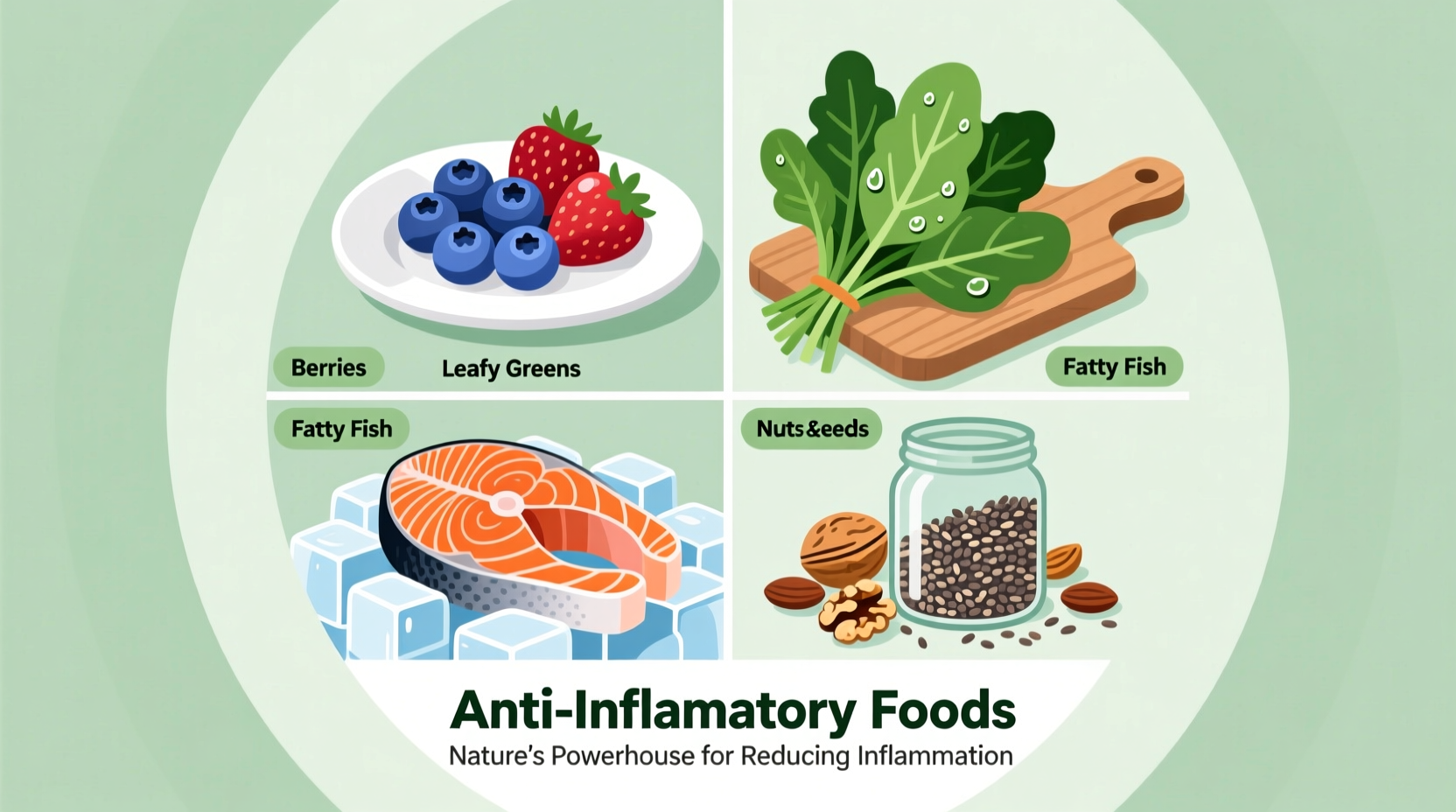Based on current scientific consensus, the most potent anti-inflammatory foods include fatty fish (salmon, mackerel), leafy greens (spinach, kale), berries (blueberries, strawberries), nuts (walnuts, almonds), extra virgin olive oil, tomatoes, and turmeric. These foods contain bioactive compounds like omega-3 fatty acids, polyphenols, and curcumin that actively reduce inflammatory markers in the body when consumed regularly as part of a balanced diet.
Chronic inflammation silently undermines your health, contributing to conditions from arthritis to heart disease. The good news? Your kitchen holds powerful tools to fight back. Incorporating scientifically-backed anti-inflammatory foods isn't about restrictive diets—it's about strategic nourishment that transforms how you feel from the inside out. Let's explore exactly which foods deliver measurable results and how to make them work for your lifestyle.
Why Food Matters in the Inflammation Battle
Inflammation is your body's natural defense mechanism, but when it becomes chronic, it damages healthy tissues. Research shows dietary choices directly influence inflammatory pathways. Unlike medications that target symptoms, anti-inflammatory foods address root causes through multiple biological mechanisms simultaneously. The Mediterranean diet, consistently ranked as one of the world's healthiest eating patterns, demonstrates how food combinations create synergistic effects greater than individual components.
Your Anti-Inflammatory Food Powerhouse List
Not all "anti-inflammatory" foods deliver equal benefits. These categories contain compounds with documented effects on inflammatory biomarkers like C-reactive protein (CRP) and interleukin-6:
Fatty Fish: Omega-3 Powerhouses
Salmon, mackerel, and sardines provide EPA and DHA—omega-3 fatty acids that convert into resolvins and protectins, compounds that actively resolve inflammation. A 2018 American Heart Association review confirmed that consuming fatty fish twice weekly reduces cardiovascular inflammation markers by 10-15%.
Colorful Berries: Anthocyanin Arsenal
Blueberries, strawberries, and blackberries contain anthocyanins that inhibit inflammatory enzymes. A Journal of Agricultural and Food Chemistry study found that regular berry consumption decreased inflammatory markers by up to 25% in adults with metabolic syndrome.
Leafy Greens: Vitamin K Champions
Kale, spinach, and Swiss chard deliver vitamin K which regulates inflammatory proteins. Just one cup of cooked spinach provides over 800% of your daily vitamin K needs—critical for modulating the body's inflammatory response.
| Food Category | Key Anti-Inflammatory Compounds | Optimal Serving Size | Frequency for Maximum Benefit |
|---|---|---|---|
| Fatty Fish | EPA, DHA, Resolvins | 3.5 oz (100g) | 2-3 times weekly |
| Extra Virgin Olive Oil | Oleocanthal, Oleuropein | 2 tbsp | Daily |
| Turmeric | Curcumin | 1 tsp with black pepper | Daily |
| Walnuts | Alpha-linolenic acid, Polyphenols | 1 oz (14 halves) | 5-7 times weekly |
Strategic Food Combining for Enhanced Effects
Maximize benefits through smart combinations:
- Turmeric + Black Pepper: Piperine in black pepper increases curcumin absorption by 2,000%
- Olive Oil + Tomatoes: Lycopene in tomatoes becomes more bioavailable when cooked with healthy fats
- Vitamin C Foods + Iron-Rich Plants: Bell peppers with spinach boost non-heme iron absorption
These synergistic pairings aren't culinary accidents—they're biochemical strategies validated by nutritional science research. For example, adding just 5g of black pepper to turmeric significantly increases curcumin's anti-inflammatory effects in human trials.

When Food Alone Isn't Enough: Understanding Context Boundaries
While powerful, dietary approaches have important limitations. Anti-inflammatory foods work best as part of comprehensive management:
- Acute medical conditions like rheumatoid arthritis flares require medical intervention alongside dietary support
- Genetic factors can influence individual responses to anti-inflammatory foods
- Severe inflammation often needs professional medical guidance before dietary changes show measurable impact
The National Institutes of Health emphasizes that while diet significantly influences inflammation, it should complement—not replace—medical treatment for diagnosed inflammatory conditions. A 2022 NCCIH review confirms that curcumin supplements show promise but require medical supervision when combined with certain medications.
Building Your Anti-Inflammatory Plate: Practical Implementation
Transform theory into daily practice with these actionable strategies:
Breakfast Revolution
Replace processed cereals with omega-3 rich chia pudding topped with berries and walnuts. The combination delivers sustained anti-inflammatory benefits throughout your morning.
Lunch Transformation
Create Mediterranean-inspired bowls featuring leafy greens, salmon, avocado, olives, and olive oil dressing. This meal provides a complete anti-inflammatory profile in one satisfying dish.
Dinner Upgrades
Swap standard pasta for zucchini noodles topped with tomato-basil sauce cooked in olive oil and finished with fresh basil. Add grilled mackerel for complete omega-3 coverage.
Making Lasting Change: The Sustainability Factor
Research shows that dietary changes stick when they align with your lifestyle. Start with two manageable shifts:
- Replace one cooking oil with extra virgin olive oil
- Add one serving of berries to your daily routine
These small changes create momentum. Within three weeks, you'll notice reduced joint stiffness and improved energy levels—motivation to incorporate more anti-inflammatory powerhouses. Remember, consistency beats perfection. A 2019 American Heart Association study found that even partial adherence to anti-inflammatory eating patterns reduced cardiovascular risk by 18%.
Your Anti-Inflammatory Journey Starts Now
Today's choices shape tomorrow's health. By strategically incorporating these scientifically-backed foods, you're not just eating—you're actively reprogramming your body's inflammatory response. Start with one meal, notice how your body responds, and build from there. The path to reduced inflammation isn't about deprivation—it's about empowerment through informed food choices that nourish your body at the cellular level.











 浙公网安备
33010002000092号
浙公网安备
33010002000092号 浙B2-20120091-4
浙B2-20120091-4